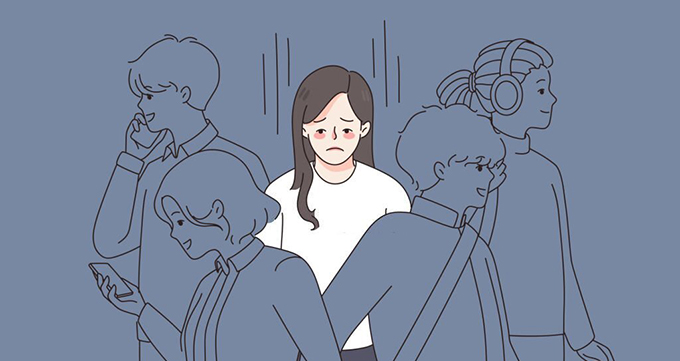
Marta is a 20-year-old student who has always been shy. But that shyness has intensified so much that it sometimes interferes with everyday activities. Since high school, she began to experience an overwhelming fear of being judged negatively by her peers and teachers.
Now, at university, Marta feels extremely anxious when she knows she will have to give a presentation in class. The night before, she can barely sleep due to his intrusive thoughts about her possible mistakes and the teasing of her classmates. She anticipates all the criticism and feels butterflies in her stomach.
Marta also experiences these symptoms in class. She usually places herself in the furthest rows and tries to leave a free space to her left and to her right. Additionally, she avoids participating in social activities for fear of saying something inappropriate or not knowing how to act. She prefers to stay at home studying or watching series.
But Marta isn’t actually shy: she suffers from social anxiety, a disorder that affects approximately 9% of women and 7% of men each year .
How can we detect it?
Also known as social phobia , social anxiety is characterized by an intense and persistent fear of social situations or performances in which the person feels they may be judged, evaluated, or humiliated by others.
And how is it different then from shyness? Well, this is just a personality tendency with respect to certain behaviors and thoughts, while social anxiety can be defined as a disabling psychological disorder and assigned to a diagnosis validated by the scientific community.
It should also be distinguished from other anxiety problems. Performing a differential diagnosis involves exploring the similarities and, especially, the differences regarding the symptoms that have brought a patient to the consultation. Some scientific articles indicate that the situations that trigger these symptoms and their impact on daily life are two reliable aspects to carry out the previous analysis.
If we look at the panic attack , for example, the triggers are diffuse, while in the disorder in question they are social situations or situations that involve public speaking, eating or drinking in front of others. In a panic attack, subsequent fear is associated with the possibility of suffering another episode, while in social anxiety it is the fear of negative social evaluation that maintains the fear.
Something similar occurs when comparing it with generalized anxiety disorder. In the latter case, fear is linked to the possible catastrophes that may occur, but they do not have to be framed in a social context. On the other hand, the impact on daily life does not consist of avoiding meetings or moments of public exposure, but rather the person with generalized anxiety experiences diffuse difficulty in controlling their worry, which generates persistent symptoms such as muscle tension, fatigue. and lack of sleep.
How does the brain of a person with social anxiety work?
In general terms, the nervous system of the affected individual learns to be alert in social situations or, simply, in the face of the possibility of an encounter with other people. It translates into the following processes:
- Activation of the amygdala . This subcortical structure plays a major role in processing challenging emotions such as fear. In patients with social anxiety, the amygdala tends to be hyperactivated , which increases the likelihood that neutral situations will be perceived as threatening.
- Involvement of the hippocampus. Involved in the formation and retrieval of memories, this brain region is especially involved in maintaining the phobia . Harmless a priori memory fragments are responsible for anticipation and fear of future situations.
- Inhibition of the prefrontal cortex. The one in charge of emotional regulation is also associated with social anxiety. Some studies have shown that the exacerbation of the emotional response to social contexts could deactivate it, preventing reason or objective data from reversing the situation.
- Anomaly in the functioning of neuronal networks involved in social perception and empathy , such as those that include the temporo-parietal areas and the anterior cingulate cortex. They are important for interpreting and responding to social signals, and their alteration can lead the person to misinterpret the intentions and attitudes of others.
Treatment and management
Psychological therapy provides the necessary tools to manage social situations for people with this diagnosis. In some cases, medication is also required if specific events such as a panic attack or an episode of dissociation have occurred.
Currently, virtual reality applied to treatment modalities such as cognitive-behavioral therapy or exposure therapy is what is producing the best results.
Likewise, the patient is recommended to practice a series of behavioral guidelines such as the following:
- Gradual training of social skills. Gradual exposure to less intimidating situations, in small, trusted groups.
- Deep breathing and muscle relaxation techniques.
- Identification and analysis of automatic negative thoughts around the situation of social anxiety.
- Physical exercise. Movement generates certain chemicals and activates metabolic processes that help regulate anxiety in general.
Sometimes, the lack of information leads us to adopt a pessimistic or inattentive attitude towards little-known diagnoses or whose symptoms have traditionally been attributed to personality traits such as shyness, in this case. Hence the importance of raising awareness under the slogans “there is no health without mental health” or “if it is not visible it does not exist?”
Author Bio: María J. García-Rubio is a Professor at the Faculty of Health Sciences at the International University of Valencia – Co-director of the VIU-NED Chair of Global Neuroscience and Social Change – Member of the Psychology and Quality of Life Research Group (PsiCal) at the International University of Valencia